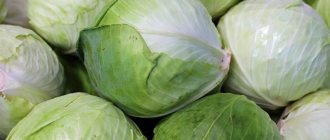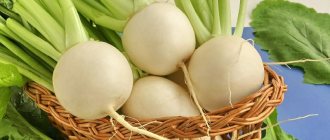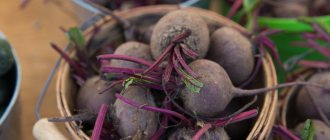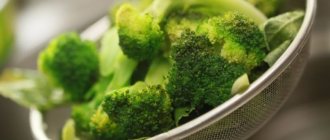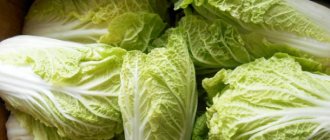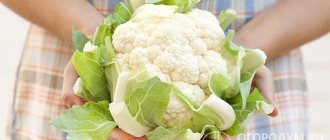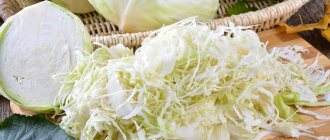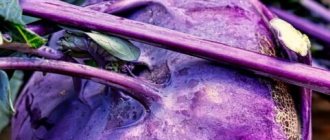Storing Brussels sprouts is a relevant topic because cabbage stores well.
In addition, it is tasty and healthy for the body. And yet, in Russian gardens it looks exotic (unusual), because Brussels sprouts have not yet gained much popularity. Brussels sprouts can be roasted, steamed, canned, and frozen. It is perfect for any meat dishes, soups, etc. Any housewife who has dealt with Brussels sprouts will want to save them for the winter. And this is what we will talk about in this article. Go?
Features of storing Brussels sprouts until spring
Brussels sprouts have a high yield. It ripens unevenly, so it is cut from the bush gradually. The collection begins with the lower heads of cabbage - they ripen faster. The first heads of cabbage are cut at the end of September, and the last ones in November.
The fact that the head of cabbage is ripe is indicated by yellowed lower leaves. When harvesting mature forks, they are removed. After removing the first batch, continue to monitor the condition of the leaves. When they turn yellow, the next batch of heads of cabbage is removed. The interval between collections is from 7 to 10 days.
Advice. To develop the forks and maintain their elasticity at the time of their growth, the top of the stem is cut off.
Brussels sprouts are frost-resistant and can withstand temperatures as low as -7°C.
Therefore, it is not scary to leave the crop in the garden until the first frost. At the same time, the heads of cabbage become sweeter and more aromatic. Ripe forks are cut off with a knife or broken off by hand so as not to damage the plant itself. For storage, dense and large heads of cabbage with a diameter of at least 3 cm are selected. Soft and loose ones are not stored for a long time, so they are consumed first.
When stronger frosts occur, the cabbage is cut down at the root and the mature heads are removed, while the unripe ones are left on the stem. The leaves are removed, leaving 2-3 at the top. The bush is buried in a box of sand in a warm place and watered regularly until the heads of cabbage ripen.
To extend the fresh shelf life of cabbage, it is dug up from the beds along with the roots. Cut off all the leaves, dig them in the sand and store them in the basement. This way the cabbage is preserved until spring.
Only whole heads of cabbage are left for storage in the refrigerator. Damaged ones quickly deteriorate and can infect healthy ones.
Fresh cabbage is regularly inspected and forks with signs of spoilage and rotting are thrown away.
Basic Rules
Brussels sprouts are a high-yielding crop and they are extremely beneficial for the human body. Therefore, it is necessary to preserve the grown crop in order to receive all the benefits from this valuable vegetable in winter. To do this you need:
- Cabbage should be harvested last, since all its varieties are mostly late-ripening;
- This cabbage is quite resistant to cold, so you should not be afraid of the first frost. With the onset of cold weather, it will not deteriorate, but will only gain additional taste;
- But if severe frosts hit ahead of time, it is worth trimming unripe cabbage bushes at the root and placing them in a warm place, buried in a container with sand. Do not forget about regular watering until the cabbage is fully ripe.
Choosing cabbage for long-term storage
Early varieties and hybrids (Isabella, Rosella, Rudnef, Dolmik) are more suitable for canning and freezing.
Mid-season varieties and hybrids (Franklin F1, Casio, Boxer F1, Oreshki F1, Brilliant F1) are stored longer than early ones. However, for long-term fresh storage, late-ripening cabbage varieties are chosen.
The most common : Hercules, Sapphire, Gruniger, Sanda, Curl. Different varieties are stored separately.
For long-term storage, select elastic, dense forks with a diameter of 2-3 cm, uniform color, with a glossy shine. Yellowed, rotten, damaged, cracked, soft and limp ones are rejected.
Preparing the vegetable
For storage, heads of cabbage are collected in several ways:
- cut from the stem;
- cut off along with the stem, leaving a stem up to 5 cm long;
- dig up the plant with its roots.
To keep cabbage fresh, do not wash it, but only remove damaged heads. When storing on the stem, remove the leaves, leaving only 2-3 at the top.
Before freezing, the stalks of selected forks are cut off and soaked for 15 minutes in water with salt (5 tsp per 3 liters of water) so that insects hiding under the leaves emerge. Then rinse with running water and dry.
To preserve a vegetable, it is also soaked in a saline solution, then washed and dried.
Preparing for winter storage at home
You need to make sure that Brussels sprouts are well stored at the harvest stage.
The heads of cabbage must be torn off carefully, with two fingers, simply turning them in a clockwise direction. You can cut the forks with scissors to the very base.
Variety selection
Not all varieties of Brussels sprouts store equally well. This must be taken into account when choosing seeds for planting.
If you plan to store the crop all winter, you should opt for varieties such as:
- Hercules;
- Casio;
- Curl;
- Sapphire;
- Sanda.
These varieties are late ripening. They are collected at the end of autumn. Such cabbage can remain in the beds even under snow.
Different varieties are stored separately from each other . Otherwise, you may lose the entire harvest.
Preparing the vegetable
To store cabbage fresh, you do not need to wash it. The main thing is to sort the vegetables, selecting rotten and soft specimens. Dense large heads of cabbage, the diameter of which is at least 3 cm, are left for the winter. A couple of leaves are removed only from the lower forks, since most often they do not fit well to them.
For cellar storage, vegetables can be left on the main stem. There should be several leaves at the top so that the heads of cabbage can gradually ripen.
Loose and soft cabbage is not suitable for long-term storage. It needs to be processed first.
How to keep cabbage fresh
When properly stored, Brussels sprouts do not change their quality for a long time. The harvest is stored in individual heads or on the stem.
In the basement/cellar
Cabbage is stored in the basement or cellar:
- In limbo. Leaves are removed from the stems with heads of cabbage, hung with the cut or root up and covered with cling film, but not tightly. If condensation collects under the film, remove it and wrap it in a new one so that the vegetable does not rot.
- Buried in the sand . The bushes dug up with roots are cleared of leaves and planted in boxes with moistened sand or soil.
- In wooden boxes . Cut heads of cabbage, without stems, are stored in boxes. They are not washed before storage in order to preserve the top wax layer, which performs a protective function. The forks are placed tightly together in a box to reduce moisture evaporation and covered with paper or cardboard. The box is not closed with a lid to prevent condensation and mold from forming.
If the temperature in the basement is maintained at about 0°C and the air humidity is 90%, cabbage on the stems will last up to 4-5 months, cut forks - 1-3 months.
The vegetable is not only stored in the basement, but also allowed to ripen. If there are unripe heads of cabbage left on the stems, they are cut off, keeping the stem about 5 cm. Wet sand is poured into the box, the stems are buried in it to a depth of 3-4 cm. As the sand dries, the sand is moistened. Cabbage ripens and lasts up to 5 months.
Advice. When storing Brussels sprouts in the basement, ventilate it periodically.
On the balcony
Cabbage is stored on the balcony in the same way as in the basement. A more suitable way is on the stems in sand, which is regularly moistened. During storage, maintain optimal temperature and humidity levels.
It is difficult to constantly maintain the same conditions on the balcony, so this place is used in extreme cases.
In a refrigerator
Only undamaged forks are selected for storage in the refrigerator. They are placed in plastic bags or wrapped in a damp towel. Small holes are made in the bags so that condensation does not collect and the cabbage does not begin to rot. The bags are placed in compartments for storing vegetables.
Advice. In order not to violate the integrity of the large package, cabbage is folded in portions for storage.
If condensation begins to accumulate in the bag, the heads of cabbage are dried and the packaging is replaced with a new one. Shelf life at a temperature of about +10°C is 1 month, at +5°C - 2 months.
Useful tips
If you want to store Brussels sprouts in the basement, you need to periodically check the air humidity, ventilate, and keep the sand wet.
In the refrigerator, it is important to ensure that the cabbage heads do not start to spoil. If one starts to rot, it can infect others. If a lot of condensation collects in the bag, you should change the packaging and dry the forks.
Share with us your experience of storing Brussels sprouts in winter. How long did you manage to keep it? Maybe you have your own method? This is interesting not only to us, but also to other readers.
Freezing Brussels sprouts
Proper freezing preserves all the beneficial properties of cabbage and extends its shelf life up to a year.
How to freeze:
- Whole heads of cabbage without damage are selected for freezing. Cut off the stalk and immerse it in salted water for 15 minutes (5 tsp per 3 liters of water) so that insects hiding in the leaves emerge. Then rinse under running water and dry.
- Boil water (3 liters per 1 kg of vegetables). Place cabbage in boiling water for 3 minutes. Afterwards, the water is drained into a colander, and the colander with cabbage is placed in a container with ice water.
- Cooled heads of cabbage are laid out on paper towels and dried.
- Dry forks are laid out on a tray and placed in the freezer in the fast freezing mode.
- When the heads of cabbage are frozen, they are taken out and placed in plastic containers or bags in portions. The container is marked with the name and date of freezing. Store in the freezer.
If there is no time for blanching, washed and dried vegetables are immediately put into bags and frozen.
Variety selection
The varieties suitable for Russia are those that ripen early, and the further north the latitude of the crop is grown, the shorter this period should be.
It is not afraid of frosts; when it freezes down to -8 degrees, it continues to grow. Gourmets claim that with such natural processing it becomes even tastier. When choosing a variety for planting, you need to find out about its yield. For example, Perfection produces on average about 5 kg of vegetables from one bush.
It is worth paying attention to the seed manufacturer. They should be purchased only from trusted agricultural companies that have been successfully developing in Russia for a long time. It is best to choose hybrid varieties, as they have higher disease resistance, produce more fruits and contain more nutrients.
Conservation
For the winter, Brussels sprouts are salted and pickled. Snacks are also made in combination with other vegetables. For canning, whole elastic heads of cabbage without damage are selected.
Advice. Wash cabbage immediately before cooking. Moisture leads to rapid deterioration of the head of cabbage.
How to pickle cabbage for the winter
For this preparation, dense heads of cabbage with a diameter of no more than 4 cm are selected.
Ingredients:
- Brussels sprouts - 1 kg;
- water - 1 l;
- salt - 2-3 tbsp. l.
Preparation:
- The prepared cabbage is immersed in boiling water for 3 minutes. Then they are placed tightly in a sterilized jar.
- Add salt to the water and bring to a boil.
- Hot brine is poured over the cabbage. Cover with a polyethylene lid.
- After cooling, store in the refrigerator.
Salty with carrots
Classic recipe for pickling Brussels sprouts.
For preparation you will need:
- Brussels sprouts - 1 kg;
- water - 1 l;
- salt - 2 tbsp. l.;
- carrots - 3 pcs.;
- sugar - 2 tbsp. l.;
- bay leaf - 2 pcs.;
- dill and peppercorns - to taste.
How to cook:
- The cabbage is sorted and washed. Large heads of cabbage are cut into 2 parts. Grate carrots. Dill is finely chopped.
- Chopped vegetables and herbs are mixed, bay leaf and pepper are added.
- To prepare the brine, add sugar and salt to hot water and bring to a boil.
- Pour hot brine over the vegetable mixture. Cover with a nylon lid.
The finished product is stored in the refrigerator.
Pickled
According to this recipe, the cabbage is moderately spicy and sweet.
Main components:
- Brussels sprouts - 1 kg;
- water - 1 l;
- sugar - 2 tbsp. l.;
- salt - 2 tbsp. l.;
- ground black pepper - 0.5 tsp;
- vinegar 9% - 1 glass.
Cooking algorithm:
- The heads of cabbage are cut in half and placed tightly in a sterilized jar.
- Prepare the marinade: add sugar, salt and pepper to the water and bring to a boil. After boiling, pour in vinegar and remove from heat.
- Hot marinade is poured over the cabbage. Cover the jar with a lid and sterilize for 20 minutes.
- Then the lid is screwed on. The jar is turned over and covered with a blanket. Leave until completely cool.
The finished snack is stored in the cellar.
Marinated with butter
To prepare marinated Brussels sprouts with butter, you will need the following ingredients:
- Brussels sprouts - 1 kg;
- carrots - 2-3 pcs.;
- garlic - 2 cloves;
- vegetable oil - 3 tbsp. l.;
- vinegar 9% - 4 tbsp. l.;
- sugar - 4 tbsp. l.;
- salt - 0.5 tbsp. l;
- water - 1 l.
Step-by-step preparation:
- The prepared cabbage is cut into 2 parts. Carrots are cut into slices. Garlic is passed through a press.
- Place the water on the stove and bring to a boil. Add carrots and cabbage and boil for 5 minutes. Remove from the water and place in sterilized jars, after adding garlic.
- Add sugar and salt to the vegetable broth, add oil and bring to a boil. After boiling, add vinegar and remove from heat.
- The hot marinade is poured over the vegetables and the lids are screwed on.
The finished snack is stored in the basement.
Spicy salad with vegetables
An appetizer according to this recipe is served not only as a salad, but also as a side dish for poultry and meat.
For preparation you will need:
- Brussels sprouts - 1 kg;
- carrots - 400 g;
- sweet bell pepper - 300 g;
- hot pepper (small) - 4 pcs.;
- garlic - 3 cloves;
- bay leaf - 4 pcs.;
- allspice peas - 8 pcs.;
- fresh parsley - 1 bunch;
- dill seeds - 1 tbsp. l.;
- vinegar 9% - 8 tbsp. l.;
- water - 1.2 l;
- salt - 1 tbsp. l.;
- sugar - 1 tbsp. l.
From the specified amount of ingredients you get 4 cans of 0.5 liters each.
Step-by-step preparation:
- The heads of cabbage are washed and dried. Cut carrots into slices, sweet peppers into large slices. Peel the pepper and garlic.
- Dip the forks into boiling water for 4 minutes, then place them in a colander and lower them into ice water for 5 minutes. This procedure preserves their beautiful green color.
- Cabbage, carrots and sweet peppers are mixed.
- In each jar put 1 clove of garlic, 1 pod of hot pepper, 2 allspice peas, 1 bay leaf, a pinch of dill seeds, parsley. Place the vegetable mixture on top.
- Prepare the marinade: add sugar and salt to hot water and boil.
- Pour the hot marinade over the vegetables and pour 2 tbsp on top. l. vinegar.
- Cover with lids and sterilize for 15 minutes. The lids are rolled up. The jars are turned over and placed under a blanket.
After cooling, the finished product is stored in a cool, dark place.
Terms and conditions of storage of Brussels sprouts
The optimal storage temperature for fresh Brussels sprouts is from 0 to +4°C, relative air humidity is 95%. Fresh heads of cabbage are stored in the refrigerator in the vegetable storage compartment. For packaging, plastic bags with holes are used. Shelf life - up to 2 months.
When storing in a cellar or basement, monitor the microclimate and condition of the vegetables. If condensation appears, change the packaging. Heads of cabbage with signs of spoilage and rot are removed.
The vegetable is stored in separate heads in a wooden box or suspended on the stem, buried in the sand. Subject to optimal storage conditions, cabbage on stems can be stored for up to 4-5 months, and cut cabbage for 1-3 months.
Properly frozen heads of cabbage are stored in plastic bags or plastic containers in the freezer at -18°C for one year.
Reference. Thawed product cannot be re-frozen.
The canned product is stored in a cellar, basement or refrigerator at a temperature of no more than +15°C. At higher temperatures it deteriorates quickly.
The shelf life of the canned product is 1 year. Unsterilized preparations, closed with nylon lids, are stored in the refrigerator for no more than 2 months.
